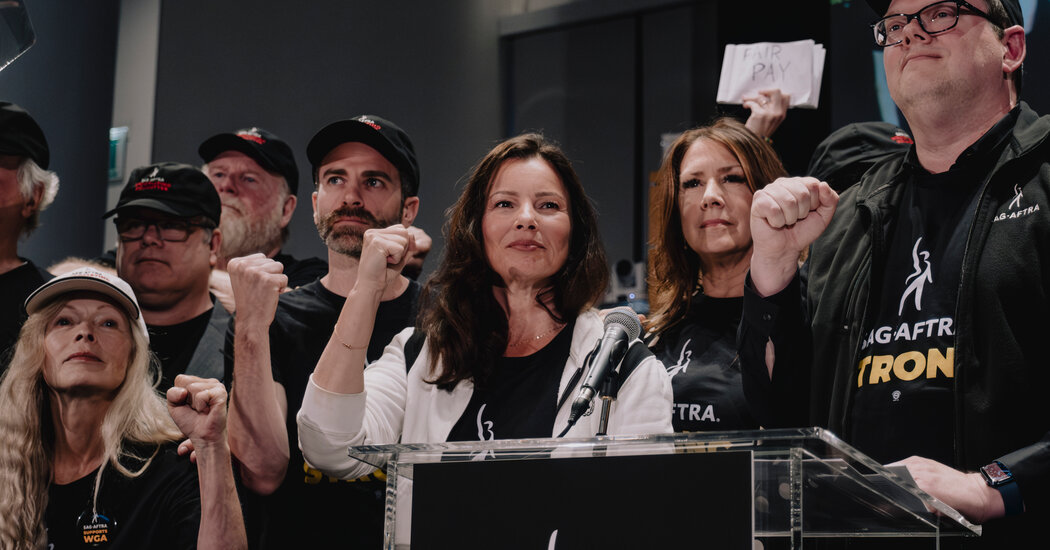For the first time in decades, Hollywood is set to shut down completely because of labor disputes.
Thousands of movie and television writers have been on strike against the studios since May, and bargaining has yet to resume. Today, 160,000 actors will join them on the picket line, after voting yesterday to approve a strike.
The industrywide shutdown is a big deal. The last time Hollywood writers and actors were on strike at the same time was in 1960, when Marilyn Monroe was starring in films and Ronald Reagan was president of the Screen Actors Guild.
And it is likely to have a big impact on Californians, including those not directly involved in the film and television industry.
A 100-day work stoppage by Hollywood writers in 2007 cost the California economy an estimated $2.1 billion and some 37,000 jobs, as entertainment workers cut back on spending and a number of restaurants and clothing stores that catered to Hollywood went out of business. Those industries are likely to be affected this time around, too, as are many TV shows and movies.
The strikes come at a time when the growth of streaming services has upended the entertainment industry. The studios say their profit margins have shrunk and share prices have plummeted as cable and network TV viewership has collapsed; workers say they’re struggling to earn a living wage and need new protections in a rapidly changing workplace.
The actors and writers are joining in a wave of labor activism that’s taken off nationally — and particularly in California, where hotel employees, dockworkers and schoolteachers have all recently walked off the job.
California leaders have called the moment a “hot labor summer,” with the state’s high cost of living fueling worker solidarity in a number of industries. Roughly half of the nation’s large work stoppages so far in 2023 have taken place in California.
“What’s happening to us is happening across all fields of labor,” Fran Drescher, the president of SAG-AFTRA, the screen actors’ union, said at a news conference yesterday. “When employers make Wall Street and greed their priority, and they forget about the essential contributors who make the machine run, we have a problem.”
It will be the first major strike by the screen actors since 1980, and A-listers may show up today to picket outside Hollywood studios. Ike Barinholtz, an actor and writer known for “The Mindy Project,” has been a regular on the writers’ picket lines over the last couple of months; he told my colleague Corina Knoll that he envisioned a longer line of celebrities now that the actors were walking out.
“I mean, can you imagine if the Rock came out here?” he said yesterday outside Paramount Pictures Studios, referring to the actor Dwayne Johnson. “The amount of hullabaloo if Dwayne came out here and was walking around? But regardless of who shows up, this is something we have to do right now.”
The actors’ previous three-year contract expired at 11:59 p.m., after being extended on June 30 to allow for continued talks. The two sides are divided on a range of issues, including pay and the use of artificial intelligence. Read more about the dispute’s central issues here.
The Alliance of Motion Picture and Television Producers said in a statement that it was “deeply disappointed” that the union had decided to walk away from the talks. “This is the union’s choice, not ours,” the group said.
It’s unclear how long the strike may last. The writers have been walking the picket line for more than 70 days.
The actors’ walkout in 1980 lasted more than three months.
For more:
Where we’re traveling
How to spend 36 hours in Santa Barbara.
Tell us
What books would you put on a California reading list? What fiction or nonfiction best captures the Golden State, and why?
Email us at CAtoday@nytimes.com with your suggestions. Please include your name and the city where you live.
And before you go, some good news
Every week, a small group of women in Pleasanton meets to practice ikebana, the Japanese craft of arranging flowers, The Mercury News reports.
Ikebana follows strict rules that dictate the appearance and form of flower arrangements. Alice Huang, the group’s instructor, studied ikebana for over a decade while growing up in Taiwan.
The women in the group are 75 to 95 years old, and most of them are ikebana novices. They joined primarily for the bonding experience. The group helps address one of the most common issues facing older Americans: a lack of socialization.
“These seemingly simple things are so meaningful,” Ashwin Kotwal, an assistant professor of geriatrics at the University of California, San Francisco, told The Mercury News. “Having that weekly opportunity to get together and discuss a very specific skill is just incredibly valuable.”
Thanks for reading. I’ll be back on Monday. Enjoy your weekend. — Soumya
P.S. Here’s today’s Mini Crossword.
Briana Scalia, Maia Coleman and Sadiba Hasan contributed to California Today. You can reach the team at CAtoday@nytimes.com.
Sign up here to get this newsletter in your inbox.

